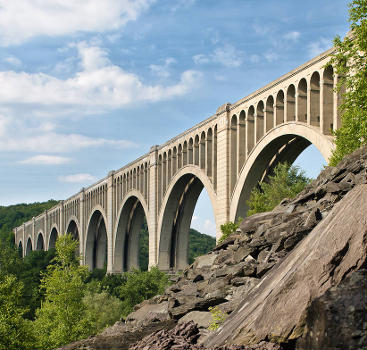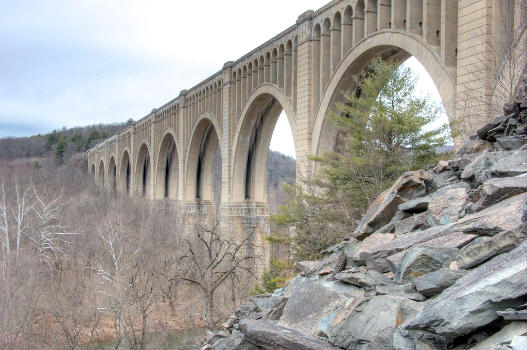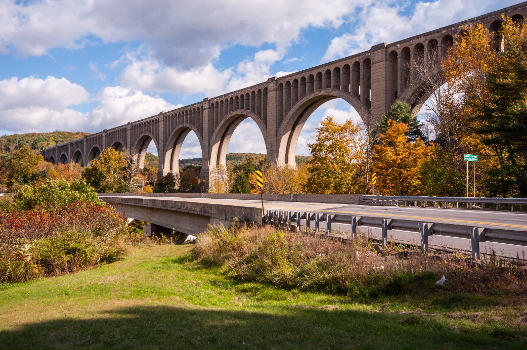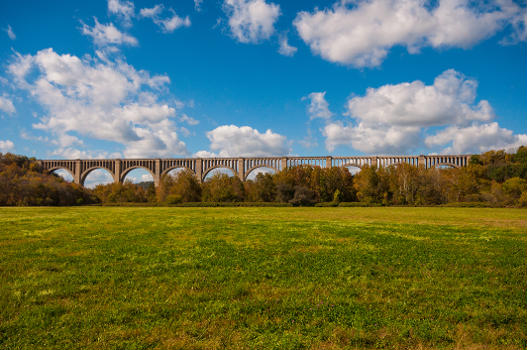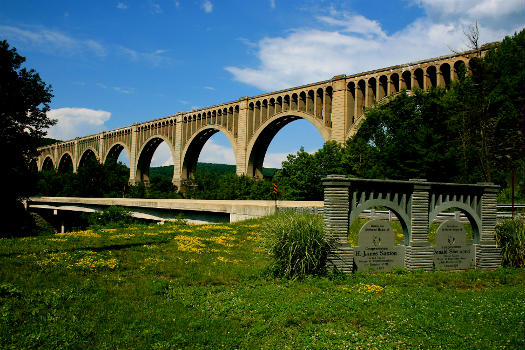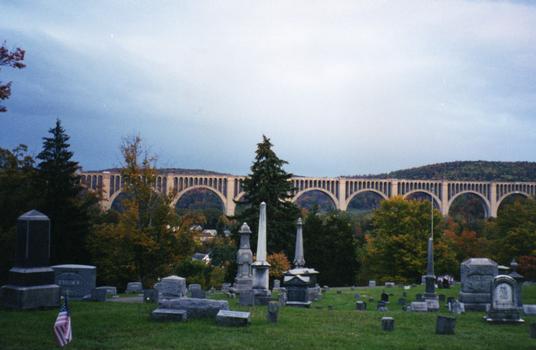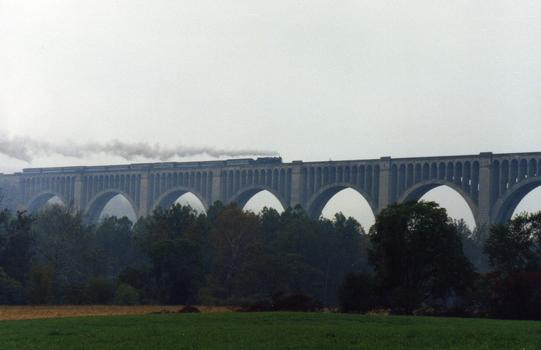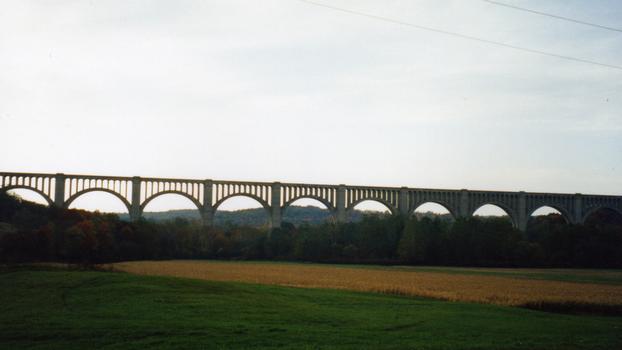General Information
| Other name(s): | Tunkhannock Creek Viaduct; Nicholson Bridge |
|---|---|
| Beginning of works: | May 1912 |
| Completion: | 6 November 1915 |
| Status: | in use |
Project Type
| Structure: |
Deck arch bridge |
|---|---|
| Function / usage: |
Railroad (railway) bridge |
| Material: |
Reinforced concrete bridge Structurae Plus/Pro - Subscribe Now! |
| Construction method: |
arches: In-situ casting on falsework |
Awards and Distinctions
| 1995 |
for registered users |
|---|---|
| 1977 |
for registered users |
| 1975 |
for registered users |
Location
| Location: |
Nicholson, Wyoming County, Pennsylvania, USA |
|---|---|
| Crosses: |
|
| Coordinates: | 41° 37' 22.41" N 75° 46' 35.87" W |
Technical Information
Dimensions
| height | 73.1 m | |
| total length | 723.9 m | |
| span lengths | 10 x 54.9 m | |
| number of spans | 10 | |
| number of tracks | 2 | |
| track gauge | 1 435 mm |
Materials
| piers |
reinforced concrete
|
|---|---|
| arches |
reinforced concrete
|
| abutments |
reinforced concrete
|
Excerpt from Wikipedia
Tunkhannock Creek Viaduct (also known as the Nicholson Bridge and the Tunkhannock Viaduct) is a concrete deck arch bridge on the Nicholson Cutoff rail segment of the Norfolk Southern Railway Sunbury Line that spans Tunkhannock Creek in Nicholson, Pennsylvania, in the United States. Measuring 2,375 feet (724 m) long and towering 240 feet (73.15 m) when measured from the creek bed (300 feet (91.44 m) from bedrock), it was the largest concrete structure in the world when completed in 1915 and still merited "the title of largest concrete bridge in America, if not the world" 50 years later.
Built by the Delaware, Lackawanna and Western Railroad (DL&W), the bridge is owned today by Norfolk Southern Railway and is used daily for regular through freight service.
The DL&W built the viaduct as part of its 39.6-mile (63.7 km) Nicholson Cutoff, which replaced a winding and hilly section of the route between Scranton, Pennsylvania, and Binghamton, New York, saving 3.6 miles (5.8 km), 21 minutes of passenger train time, and one hour of freight train time. The bridge was designed by the DL&W's Abraham Burton Cohen; other key DL&W staff were G. J. Ray, chief engineer; F. L. Wheaton, engineer of construction; and C. W. Simpson, resident engineer in charge of the construction. The contractor was Flickwir & Bush, including general manager F. M. Talbot and superintendent W. C. Ritner.
History
Construction on the bridge began in May 1912 by excavating all 11 bridge piers to bedrock, which was up to 138 feet (42 m) below ground. In total, excavation for the viaduct removed 13,318,000 cubic yards (10,182,000 m³) of material, more than half of that rock.
Almost half of the bulk of the bridge is underground. At mid-construction, 80,000 cubic yards (61,000 m³) of concrete had gone into its substructures, and it was estimated that construction would require 169,000 cubic yards (129,000 m³) of concrete and 1,140 short tons (1,030 t; 1,020 long tons) of steel. The steel estimate proved accurate; the bridge ultimately used a bit less concrete than expected: 167,000 cubic yards (128,000 m³), making the total weight approximately 670,000,000 pounds (300,000,000 kg).
The bridge was dedicated on November 6, 1915, along with the opening of the Nicholson Cutoff.
Construction photos along with a short history of the bridge were published by the Nicholson Area Library in a brochure in 1976. It was listed on the National Register of Historic Places on April 11, 1977.
Since 1990, the local community has celebrated the building of the bridge on the second Sunday of September with "Nicholson Bridge Day", a street fair, parade, and other activities. The 100th-anniversary celebration was held in September 2015.
Text imported from Wikipedia article "Tunkhannock Viaduct" and modified on July 22, 2019 according to the CC-BY-SA 4.0 International license.
Participants
- George J. Ray (chief engineer)
- Abraham Burton Cohen (design engineer)
- David W. Flickmir (builder)
- Lincoln Bush (builder)
Relevant Web Sites
Relevant Publications
- Construction Methods on the Tunhannock and Martin's Creek Viaducts, Lackawanna Railroad. In: Journal of the American Concrete Institute (ACI Journal Proceedings), v. 12, n. 2 ( 1916).
- (1990): Les grands ponts du monde: Hors d'Europe. Brissaud, Poitiers (France), pp. 130.
- (1984): Great American Bridges and Dams. A National Trust Guide. John Wiley & Sons, New York (USA), pp. 147.
- About this
data sheet - Structure-ID
20001299 - Published on:
10/02/2001 - Last updated on:
26/10/2023

